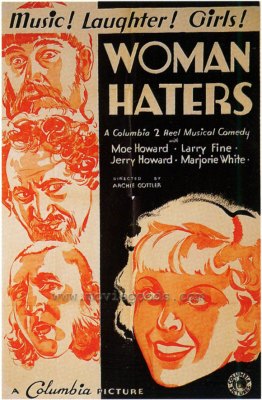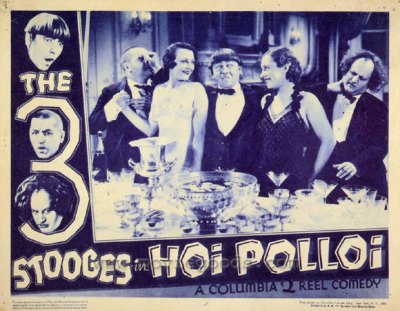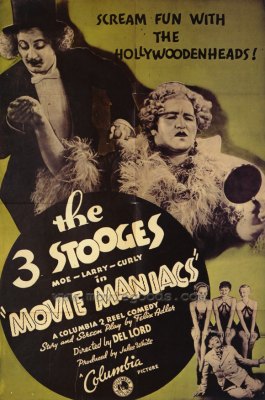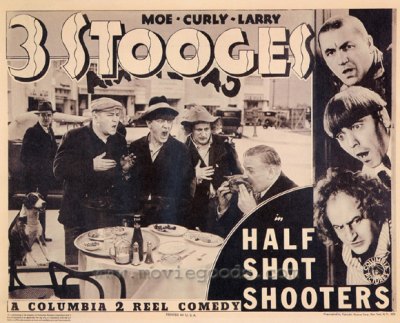| Reviews & Columns |
|
Reviews DVD TV on DVD Blu-ray 4K UHD International DVDs In Theaters Reviews by Studio Video Games Features Collector Series DVDs Easter Egg Database Interviews DVD Talk Radio Feature Articles Columns Anime Talk DVD Savant Horror DVDs The M.O.D. Squad Art House HD Talk Silent DVD
|
DVD Talk Forum |
|
|
| Resources |
|
DVD Price Search Customer Service #'s RCE Info Links |
|
Columns
|
|
|
Three Stooges Collection - Volume One - 1934-1936, The
Sony Pictures Home Entertainment is at long last releasing the Three Stooges' classic two-reel comedies in a format fans of the team have been begging for ever since the debut of DVD. Since February 1999, the Stooges have been subject to overpriced "themed" collections (perversely grouping almost indentical shorts in some cases), mucked up reissues of the same two-reelers over and over again, and an over-hyped, unasked-for colorization process. However, The Three Stooges Collection - Volume One - 1934-1936 finally does the team right. Presented here in chronological order are the Stooges' first 19 two-reel comedies for Columbia Pictures, in splendiferous new transfers that will be a revelation even for die-hard fans who've already seen the shorts dozens of times before.
The two-reelers in this collection are consistently excellent, among the best short comedies ever made. This will come as a surprise to those who stubbornly insist the Three Stooges' trademark low-brow eye-pokes and head-slaps appeal only to audiences with I.Q.s not much higher than the Stooges themselves. In one sense the team was a victim of their own longevity: I've always felt that had the Three Stooges died in an airplane crash around 1937 "serious" cinema historians would unquestionably rank them in the pantheon of great film comedians: Chaplin, Keaton, Harold Lloyd, W.C. Fields, Laurel & Hardy, the Marx Bros. Instead, the Stooges, in their various incarnations, prolifically continued making movies and appearing in other media until about 1970, long after virtually all their contemporaries had retired or died out.
The team went through many peaks and valleys, usually but not exclusively tied to personnel changes over the years: their famous shorts at Columbia were preceded by appearances in both shorts and feature films with Ted Healy leading the group, initially Moe Howard, Shemp Howard (Moe's real-life older brother), and Larry Fine. Moe and Shemp's kid brother Jerome "Curly" Howard replaced Shemp in 1932, and when Curly was incapacitated by a stroke in 1946, Shemp rejoined the team until his death in 1955. Joe Besser was the next "third stooge" for a couple of years, and finally "Curly-Joe" DeRita joined the team in the late-1950s, just as a new generation discovered them on television, for a series of feature films aimed primarily at kids.
Unquestionably their best all-around shorts were the early Columbia two-reelers featuring Curly (billed on these shorts as "Curley"); the 19 mini-movies in this collection have the manic, irreplaceable comedian in top form.
Woman Haters (1934)
The team's first Columbia short is an anomoly directed by Archie Gottler and written by his son Jerome, neither of whom did any other shorts with the Stooges. It's closer in content and spirit to their earlier shorts with Ted Healy. Told entirely in verse, this "musical novelty" has the team joining a women's anonymous fraternal organization, only Larry is set to get married and go off on his honeymoon that very night. Though more silly than funny, it's a strangely endearing little film, due in no small part to the perky charm of top-billed Marjorie White, a fireball of Betty Boop/Thelma Todd-like energy who died too soon, in an automobile accident shortly after this was made. One of the Stooges' best foils, silent comedy veteran Bud Jamison, makes his series debut; indeed it's Jamison, not Moe, who delivers the series' first "eye-poke." The real surprise for some will be the uncredited appearance of a rail-thin Walter Brennan as a train conductor, just two years away from his first Oscar-winning performance in Come and Get It. (****)
Punch Drunks (1934)
Boxing promoter Moe finds a heavyweight champ in cafe waiter Curly, who goes bananas anytime he hears Larry play "Pop Goes the Weasel" on the violin. This is the only short in which the Stooges are credited as writers but this is overstated: they sat in on the development of most of their shorts, contributing gags and bits of business, and it's seems likely that notoriously stingy studio head Harry Cohn balked at paying the team twice. In any case this is one of the team's all-time best comedies. Among the highlights, Larry's mad chase through the streets of Hollywood after his fiddle gets busted, and Arthur Housman (who spent the vast majority of his career playing comic drunks) as a frustrated ringside timekeeper. (*****)
Men in Black (1934)
The only Three Stooges short ever nominated for an Academy Award (it lost to La Cucaracha, remembered today only for its early 3-strip Technicolor photography) has the team running amuck in the "Los Arms Hospital." It's basically another transitional work, a throwback to a kind of anarchic style of comedy that had been popular in the late-1920s and early-'30s (best personified by the Marx Bros.), with wild sight gags and weird, surreal moments. Jeanie Roberts' Gracie Allen-esque hiccuping nurse is pretty hard to take, but some of the material is priceless, particularly Larry's demented behavior throughout. Around this time, Hal Roach and other producers were getting out of the short subjects business, and many veterans from the "Lot of Fun" turn up in these shorts, in this case Laurel & Hardy favorite Billy Gilbert as an insane patient. (****)
Three Little Pigskins (1934)
Gangster/gamblers (including tough guy Walter Long, another Laurel & Hardy favorite) recruit Moe, Larry, and Curly as ringers for their private football game, a hilarious companion to the finale of the Marx Bros. similar Horse Feathers. This short is remembered for Lucille Ball's supporting role as a gangster's moll; she was just 23 at the time and her hair is platinum blonde. (****)
Horses' Collars (1935) [new to DVD]
Weird but very funny short starts out as a contemporary private eye spoof, then abruptly shifts gears and becomes a Western parody! A la Punch Drunks, Curly goes ape-shit every time he sees a mouse, placated only when Moe and Larry stuff his face with cheese. ("Moe, Larry, the cheese! Moe, Larry, the cheese!") Perennial comic cop and hotel dick Fred Kelsey appears unbilled as Detective Hyden Zeke, in a surreal bit that finds Curly with creepy eyes painted on his eyelids. (**** 1/2)
Restless Knights (1935)
Moe, Larry, and Curly are, respectively, the Count of Fife, the Duke of Durham, and the Baron of Graymatter in this medieval spoof, which features Walter Brennan as the trio's ancient father. Another early short made by hands not normally associated with the team, including silent director Charles Lamont, who later would helm a number of Abbott & Costello's lesser features. (****)
Pop Goes the Easel (1935)
The Stooges are mistaken for art students in this short, memorable for its clay-throwing finale; it's also the first Columbia short to find the team as low-brow destructors of high-brow pretentiousness. One of the lesser shorts in this collection, though still quite funny. Moe and Larry's daughters appear unbilled as the girls playing hopscotch. (*** 1/2)
Uncivil Warriors (1935) [new to DVD]
The Stooges go undercover as Union spies masquerading as Confederate officers in this hilarious Civil War comedy, one of their finest. Full of laughs and Curly's wonderfully manic energy, and it includes a routine the team would frequently revive: the old pastries filled with feathers gag (literally!). Highlight: Curly's attempt to tell a joke: "I got a better one for the Colonel. There were three men in three beds, they only had two blankets. How'd they keep warm? They turned on the heat! Nyuk nyuk nyuk!" (*****)
Pardon My Scotch (1935) [new to DVD]
Watch Moe break his ribs! Heralding the end of Prohibition, this short finds the Stooges whipping up their own special brand of "scotch," and later masquerading as Scottish whiskey-makers at an upscale party. The real fun, however, is the opening set piece, with the Stooges as inept carpenters. In one scene, Moe is standing on a table Curly saws in half, sending Moe crashing to the floor. The gag went wrong and Moe broke several ribs and suffered a concussion, but you'd never know it. In a remarkable bit of the-show-must-go-on dedication, Moe gets up, says his line, and manages to slap Curly before the take ends. In a bit of Yiddish humor, soon to vanish from the shorts, Larry toasts a whiskey distributor with Ver derharget! ("Drop dead!") (****)
Hoi Polloi (1935)
It's Pygmalion, Stooge-style, as a professor tries to fashion three garbage men (guess who?) into "gentlemen." Variations of this theme turned up again and again in the team's comedies; this short was remade at least twice (as Half-Wits Holiday, Curly's last, and as Pies and Guys with Joe Besser), while a big chunk of footage (a funny dancing lesson sequence) turned up in another Curly classic, In the Sweet Pie and Pie. (****)
Three Little Beers (1935)
Another of the team's all-time best, this great short sets brewery delivery men Moe, Larry, and Curly loose on a golf course where they create all manner of havoc. Moe fills the fairway with divots, Curly chops down a tree, and Larry, trying to pull a pesky root, ruins a green. The swell finish has them running from from beer barrels when they roll off their truck, parked on a steep hill. (The neighborhood where this was filmed is still much the same, just north of Echo Park, on the other side of Sunset Boulevard in Los Angeles.) (*****)
Ants in the Pantry (1936) [new to DVD]
This was the first of seven Stooge shorts directed by "Preston Black," actually Jack White, producer-director Jules White's brother, and for my money the Stooges' best director. All of his shorts with the team are distinctive and have strong comic pacing, and the humor is a bit wilder and anarchic. This one starts off with a great sight gag: Curly grabs a ladder leaning against a telephone pole and, perfectly timed, moments later a utility worker crashes to the ground. The trio play pest exterminators who, for want of business, also provide the pests. The humor here is atypical but uproariously funny nonetheless because the Stooges are so gleefully amoral: at an upscale house they unleash a veritable plague of rats, moths, and ants, literally tossing vermin on passersby. (**** 1/2)
Movie Maniacs (1936) [new to DVD]
The Stooges may "know nuthin' about makin' movies," but as Moe says, "There's a couple of thousand people in pictures now who know nothin' about it. Three more won't make any difference." Alas, this short doesn't live up to its potential, though film buffs will enjoy the references to Mutiny on the Bounty and the scene where Curly tries to emulate John Barrymore. Charlie Chaplin's ex-wife Mildred Harris plays the put upon leading lady. (***)
Half Shot Shooters (1936) [new to DVD]
Duped into reenlisting into the army, the Stooges become the charge of their sadistic sergeant (the great Stanley Blystone) from their doughboy days. ("Where you born in this country?" asks the enlistment officer. "No," Larry replies, "Milwaukee.") The highlight is one of the team's all-time funniest set pieces, where they blithely shoot off a big cannon destroying everything in sight. Curly highlight: an impromptu ditty about the big gun, "Oh the first shell went in there; it round and round, wo-o-ah...and it goes out there!" (**** 1/2)
Disorder in the Court (1936)
Another great "Preston Black" two-reeler, with the Stooges as star witnesses in murder trial. Full of hilarious dialogue and wild sight gags, while Larry's in fine form in one of the team's most surreally funny moments: Larry grabs a wad of Curly's chewing gum that's landed on Moe's nose, stomps on it and for no apparent reason lets out a strange victory cry. "You're in a court, not in the woods, Tarzan!" admonishes Moe. Look for the Howard's parents, who appear unbilled as members of the court audience. This is one of a handful of shorts that fell into public domain, but the presentation here is outstanding. (*****)
A Pain in the Pullman (1936) [new to DVD]
Somewhat unusual short has the Stooges more or less playing themselves, The Three Stooges, vaudevillians, whose act revolves around a trained monkey, ironically (in retrospect) named Joe. This is the one set aboard a train in which demanding, hammy actor James C. Morton (a wonderful, bald character comedian always good for a toupee gag) constantly demands service from "John-son!" (Bud Jamison), who keeps hitting his head on the ceiling of his berth. Features one of the series' best gags, the kind of vaguely politically incorrect joke that would never be done today: a very Jewish-looking booking agent picks up the phone, and in a thick Yiddish accent answers, "Goldstien, Goldberg, Goldblatt & O'Brien...O'Brien speaking!" (**** 1/2)
False Alarms (1936)
The Three Stooges are firemen in this short but, being stooges, are more like the firemen in Ray Bradbury's Fahrenheit 451. Lots of great footage of Hollywood near Columbia's studio at Sunset and Gower. There's a funny, extended scene where the trio take their girlfriends for a joy ride in the firechief's (Stanley Blystone again) new car, with the expected disastrous results. (****)
Whoops, I'm an Indian! (1936)
The Stooges play crooked gamblers in a frontier town, on the run after their scam is discovered. What follows are some great wilderness gags, including a side-splitting running gag with an impatient, never-satisfied Moe using increasingly bigger fish he catches as bait: "Go fetch your old man!" Moe growls. Bud Jamison is terrific as a French-Canadian trapper duped into "marrying" Indian squaw Curly. (*** 1/2)
Slippery Silks (1936) [new to DVD]
The stooges play woodworkers who inherit their uncle's classy dress shop, but as Larry only knows how to design furniture, their new line of dresses all look like chests of drawers! (Larry's designs are revealed after a straight-faced fashion show, an odd sequence that really seems designed to impress wealthy, sophisticated women, hardly the Stooges' core audience.) Though not quite a pie fight, the cream puff-throwing finale is a highlight, clips from which Moe proudly ran as an example of the team's comedy on an episode of The Mike Douglas Show in the 1970s. This final short features a different take of their closing theme. (*** 1/2)
Video & Audio
The shorts in this collection look outstanding; all except Whoops, I'm an Indian! look like they were derived from the original nitrate camera negative and are incredibly sharp, so much so that it's easy to see how many of the sight gags were done (visible wires and hidden supports, etc.) Whoops is grainier but still looks fine; this was one of the harder shorts to see over the years, so maybe the negative was lost or had deteriorated. In most cases the shorts look almost new, and many begin with a few seconds of footage - National Recovery Act (NRA) logos, music preceding Columbia's torch lady - not seen in years. Stooge fans have been asking about a few seconds of Curly footage missing from the previous DVD release of Three Little Beers, but that too has been reinstated. The mono audio is strong, though this release includes only an English track with optional closed-captioning. Earlier Stooges releases had included subtitles in French, Spanish, and Portuguese, as well as Spanish and Portuguese audio tracks. This latter option was fascinating, particular as the dubbing artists on those tracks often did a great job imitating the team's voices.
There are, alas, no Extra Features at all. It's a shame that Sony didn't see fit to include audio commentaries or, as with their superb Buster Keaton Collection, an annotated sample script. Down the road, Sony would be wise to include supplementary material along those lines as from a marketing standpoint they would go a long way to bolster the later, lesser shorts featuring less popular "third stooges" Shemp and Joe Besser.
Parting Thoughts
Despite the lack of extras, the chronological presentation, reasonable price and especially the stunning transfers make this a DVD Talk Collector's Title. Even if you're not a Three Stooges fan you'll probably be surprised by the consistently high quality of this set of two-reel comedies.
The only question, of course, is whether Sony will release new volumes at a steady clip and actually commit itself to the entire team's long run of nearly 200 shorts, or abandon the series once sales start to dip (probably after the initial seasons featuring Shemp, circa 1950 or so) like so many '60s and '70s TV shows from virtually all the big labels. There are a lot of Stooge fans who'll want 'em all, but let's hope Sony's sales expectations are realistic enough to see this through to the end.
Film historian Stuart Galbraith IV's most recent essays appear in Criterion's three-disc Seven Samurai DVD and BCI Eclipse's The Quiet Duel. His audio commentary for Invasion of Astro Monster is now available.
|
| Popular Reviews |
| Sponsored Links |
|
|
| Sponsored Links |
|
|
| Release List | Reviews | Shop | Newsletter | Forum | DVD Giveaways | Blu-Ray | Advertise |
|
Copyright 2024 DVDTalk.com All Rights Reserved. Legal Info, Privacy Policy, Terms of Use,
Manage Preferences,
Your Privacy Choices | |||||||

















